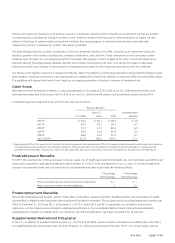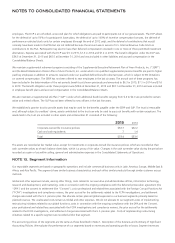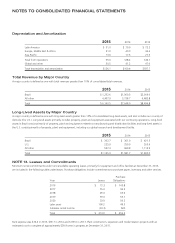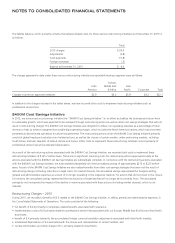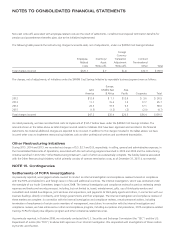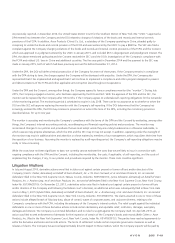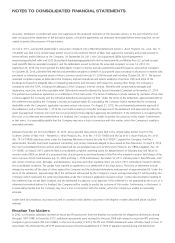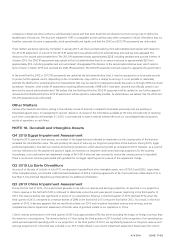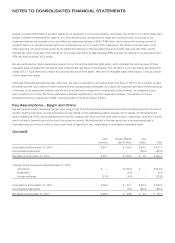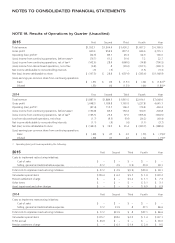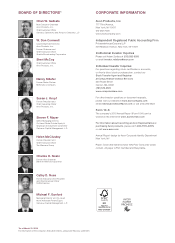Avon 2015 Annual Report Download - page 133
Download and view the complete annual report
Please find page 133 of the 2015 Avon annual report below. You can navigate through the pages in the report by either clicking on the pages listed below, or by using the keyword search tool below to find specific information within the annual report.companies in Brazil was done without a valid business purpose and that Avon Brazil did not observe minimum pricing rules to define the
taxable basis of excise tax. The structure adopted in 1995 is comparable to that used by many other companies in Brazil. We believe that our
Brazilian corporate structure is appropriate, both operationally and legally, and that the 2002 and 2012 IPI assessments are unfounded.
These matters are being vigorously contested. In January 2013, we filed a protest seeking a first administrative level review with respect to
the 2012 IPI assessment. In July 2013, the 2012 IPI assessment was upheld at the first administrative level and we have appealed this
decision to the second administrative level. The 2012 IPI assessment totals approximately $258, including penalties and accrued interest. In
October 2010, the 2002 IPI assessment was upheld at the first administrative level at an amount reduced to approximately $23 from
approximately $55, including penalties and accrued interest. We appealed this decision to the second administrative level, which ruled in
favor of Avon in March 2015 and canceled the 2002 IPI assessment. The 2002 IPI assessment remains subject to appeal by the government.
In the event that the 2002 or 2012 IPI assessments are upheld at the last administrative level, it may be necessary for us to provide security
to pursue further appeals, which, depending on the circumstances, may result in a charge to earnings. It is not possible to reasonably
estimate the likelihood or potential amount of assessments that may be issued for subsequent periods (tax years up through 2009 are closed
by statute). However, other similar IPI assessments involving different periods (1998-2001) have been canceled and officially closed in our
favor by the second administrative level. We believe that the likelihood that the 2002 IPI assessment will be upheld on any further appeal is
remote and the likelihood that the 2012 IPI assessment will be upheld is reasonably possible. As stated above, we believe that the 2002 and
2012 IPI assessments are unfounded.
Other Matters
Various other lawsuits and claims, arising in the ordinary course of business or related to businesses previously sold, are pending or
threatened against Avon. In management’s opinion, based on its review of the information available at this time, the total cost of resolving
such other contingencies at December 31, 2015, is not expected to have a material adverse effect on our consolidated financial position,
results of operations or cash flows.
NOTE 16. Goodwill and Intangible Assets
Q4 2015 Egypt Impairment Assessment
During the 2015 year-end close process, our analysis of the Egypt business indicated an impairment as the carrying value of the business
exceeded the estimated fair value. This was primarily the result of reducing our long-term projections of the business. During 2015, Egypt
performed generally in line with our revenue and earnings projections, which assumed growth as compared to 2014. However, as a result of
currency restrictions for the payment of goods in Egypt, we lowered our long-term revenue and earnings projections for the business.
Accordingly, a non-cash before tax impairment charge of $6.9 ($6.9 after tax) was recorded to reduce the carrying amount of goodwill.
There is no amount remaining associated with goodwill for our Egypt reporting unit as a result of this impairment charge.
Q3 2015 Liz Earle Divestiture
As a result of the sale of Liz Earle in July 2015, we disposed of goodwill and other intangible assets, net of $124.3 and $28.2, respectively.
Other intangible assets, net included indefinite-lived trademarks of $23.6, licensing agreements of $3.0 and customer relationships of $1.6.
See Note 3, Discontinued Operations and Divestitures for additional information.
Q3 2013 China Impairment Assessment
During the first half of 2013, China performed generally in line with our revenue and earnings projections. As assumed in our projections,
China’s revenue in the first half of 2013 continued to deteriorate versus the prior-year period; however, beginning in the third quarter of
2013, this revenue decline was significantly in excess of our assumptions. Revenue in the third quarter of 2013 declined 67% versus the
third quarter of 2012, compared to a revenue decline of 28% in the first half of 2013 versus the first half of 2012. As a result, in the third
quarter of 2013, it became apparent that we would not achieve our 2013 and long-term forecasted revenue and earnings, and we
completed an interim impairment assessment of the fair value of goodwill related to our operations in China.
China’s revenue performance in the third quarter of 2013 was approximately 67% less (when excluding the impact of foreign currency) than
the revenue in our projections. The revenue decline in China during the third quarter of 2013 resulted in the recognition of an operating loss
while we had expected operating profit in our projections. In the third quarter of 2013, we significantly lowered our long-term revenue and
earnings projections for China that was included in our DCF model utilized in our interim impairment assessment. Based upon this interim
A V O N 2015 F-51
7553_fin.pdf 123


